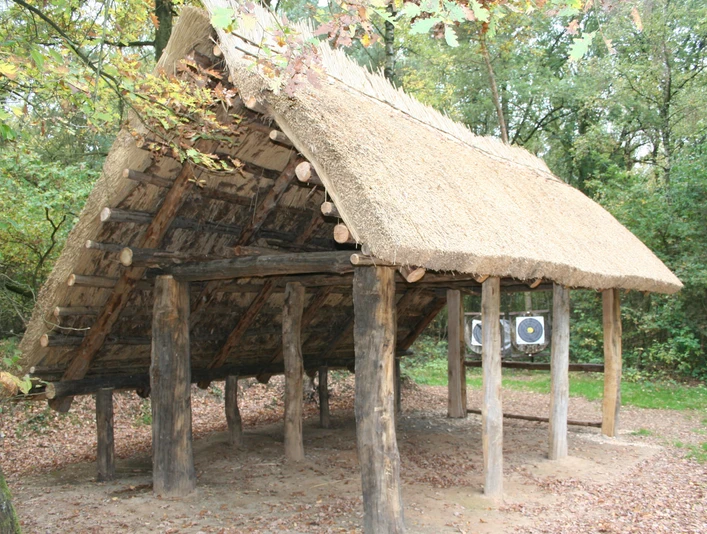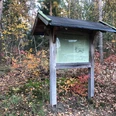Anyone who takes a closer look at north-western European early history - roughly the period 400 to 800 AD - and follows in the footsteps of the Migration Period and Merovingian period, for example, will repeatedly come across this beautiful and interesting village on the middle Weser. The "Dark Ages", as this period is also known due to its lack of written sources, are archaeologically significant in that the major political units that later played a decisive role in shaping the history of Europe developed in politically turbulent processes during this time.
The area of present-day Lower Saxony was home to the Old Saxons, a tribal group first mentioned around 150 AD. Unfortunately, they have left no written records and their cultural-historical development must therefore be investigated exclusively through archaeological research.
It was therefore a stroke of luck for national and international early history research when a burial ground was discovered on the "Heidberg", a sand dune near Liebenau, in 1953, where a group of Saxons continuously buried their dead during those centuries. This finding - an uninterrupted occupation of a cemetery through the dark centuries of the early Middle Ages - is still unique for Lower Saxony and rare for north-western Europe. Although already disturbed by the removal of sand, an excavation by the Lower Saxony State Museum, which lasted over thirty years but was interrupted by years of standstill, uncovered numerous inhumations and cremations. These yielded a large number of outstanding antiquities, some of which are unique for the Lower Saxony region, which shed light on the darkness of that time like a ray of light and thus make it possible to work out numerous aspects of the cultural-historical development of this later state-supporting tribe - more clearly than previously possible.
The Lower Saxony State Museum, traditionally significantly involved in research into the Saxons, has made numerous finds from the burial ground available to the Nienburg Museum on permanent loan and has designed an exhibition on them. The exhibition "Old Saxons" in the Nienburg Museum with the most important finds from the long-term excavation campaign of the Saxon burial ground of Liebenau/Steyerberg with valuable loans from the Hanover State Museum (Pre- and Protohistoric Department) was compiled by Dr. Hans-Jürgen Häßler on behalf of the state of Lower Saxony. Some finds are also on display in the Witten Hus home in Liebenau.
Further information:
Museum Nienburg/Weser, Leinstraße 48, 31582 Nienburg,
Phone: (05021) 12461, www.museum-nienburg.de
The Rauzwi - Lebendige Archäologie Mittelweser association offers adventure archaeology around the Old Saxons. www.rauzwi.de
Of Saxons, mead and spells - guided tour in the footsteps of the Old Saxons. Gundula Tessendorf, Tel. (05021) 5343
The area of present-day Lower Saxony was home to the Old Saxons, a tribal group first mentioned around 150 AD. Unfortunately, they have left no written records and their cultural-historical development must therefore be investigated exclusively through archaeological research.
It was therefore a stroke of luck for national and international early history research when a burial ground was discovered on the "Heidberg", a sand dune near Liebenau, in 1953, where a group of Saxons continuously buried their dead during those centuries. This finding - an uninterrupted occupation of a cemetery through the dark centuries of the early Middle Ages - is still unique for Lower Saxony and rare for north-western Europe. Although already disturbed by the removal of sand, an excavation by the Lower Saxony State Museum, which lasted over thirty years but was interrupted by years of standstill, uncovered numerous inhumations and cremations. These yielded a large number of outstanding antiquities, some of which are unique for the Lower Saxony region, which shed light on the darkness of that time like a ray of light and thus make it possible to work out numerous aspects of the cultural-historical development of this later state-supporting tribe - more clearly than previously possible.
The Lower Saxony State Museum, traditionally significantly involved in research into the Saxons, has made numerous finds from the burial ground available to the Nienburg Museum on permanent loan and has designed an exhibition on them. The exhibition "Old Saxons" in the Nienburg Museum with the most important finds from the long-term excavation campaign of the Saxon burial ground of Liebenau/Steyerberg with valuable loans from the Hanover State Museum (Pre- and Protohistoric Department) was compiled by Dr. Hans-Jürgen Häßler on behalf of the state of Lower Saxony. Some finds are also on display in the Witten Hus home in Liebenau.
Further information:
Museum Nienburg/Weser, Leinstraße 48, 31582 Nienburg,
Phone: (05021) 12461, www.museum-nienburg.de
The Rauzwi - Lebendige Archäologie Mittelweser association offers adventure archaeology around the Old Saxons. www.rauzwi.de
Of Saxons, mead and spells - guided tour in the footsteps of the Old Saxons. Gundula Tessendorf, Tel. (05021) 5343
Good to know
Openings
Access only as part of a guided tour.
Author
Mittelweser-Touristik GmbH
Lange Straße 18
31582 Nienburg/Weser
Organization
Mittelweser-Touristik GmbH
License (master data)
Mittelweser-Touristik GmbH
Nearby






